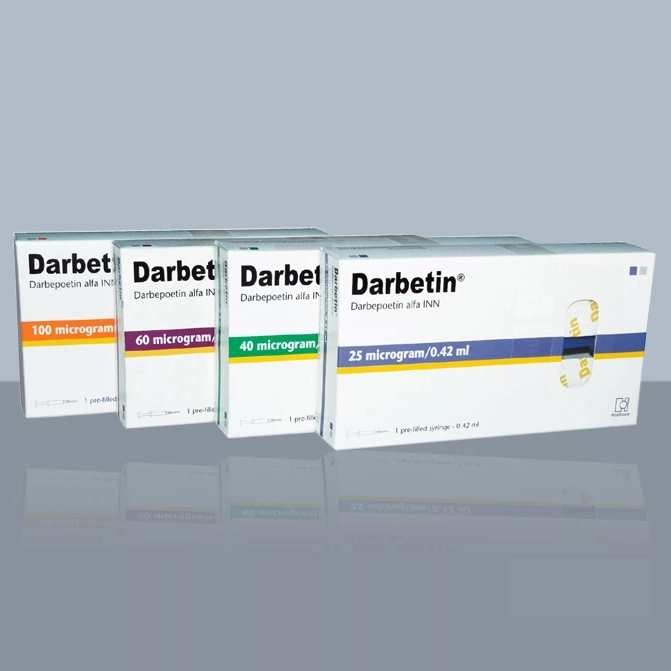100 mcg pre-filled syringe:
৳ 9,090.30
Also available as:
Indications
Darbetin is indicated for the treatment of anemia due to:
- Chronic Kidney Disease (CKD) in patients on dialysis and patients not on dialysis.
- The effects of concomitant myelosuppressive chemotherapy, and upon initiation, there is a minimum of two additional months of planned chemotherapy.
Pharmacology
Darbepoetin alfa is an erythropoiesis-stimulating protein that is produced in Chinese Hamster Ovary (CHO) cells by recombinant DNA technology. It is a 165-amino acid protein that differs from recombinant human erythropoietin in containing 5 N-linked oligosaccharide chains, whereas recombinant human erythropoietin contains 3 chains. The 2 additional N-glycosylation sites result from amino acid substitutions in the erythropoietin peptide backbone.
Dosage
Treatment of symptomatic anemia in adult and pediatric chronic renal failure patients: Anemia symptoms and sequelae may vary with age, gender and overall burden of disease. It should be administered either subcutaneously or intravenously in order to increase hemoglobin to not greater than 12 g/dl (7.5 mmol/l). Subcutaneous use is preferable in patients who are not receiving hemodialysis to avoid the puncture of peripheral veins. Treatment with Darbepoetin alfa is divided into two stages; correction and maintenance phase. Guidance is given separately for adult and pediatric patients.
Adult patients with chronic renal failure:
Correction phase:
Correction Phase:
Adult patients with chronic renal failure:
Correction phase:
- The initial dose by subcutaneous or intravenous administration is 0.45 µg/kg body weight, as a single injection once weekly. Alternatively, in patients not on dialysis, the following initial doses can also be administered subcutaneously as a single injection: 0.75 µg/kg once every two weeks or 1.5 µg/kg once monthly.
- In dialysis patients, Darbepoetin alfa may continue to be administered as a single injection once weekly or once every two weeks. Dialysis patients converting from once weekly to once every other week dosing with Darbepoetin alfa should initially receive a dose equivalent to twice the previous once weekly dose.
- In patients not on dialysis, Darbepoetin alfa may continue to be administered as a single injection once weekly or once every two weeks or once monthly. For patients treated with Darbepoetin alfa once every two weeks, after the target haemoglobin has been achieved, Darbepoetin alfa may then be administered subcutaneously once monthly using an initial dose equal to twice the previous once every two week dose.
Correction Phase:
- For patients ≥1 year of age, the initial dose by subcutaneous or intravenous administration is 0.45 µg/kg body weight, as a single injection once weekly.
- Alternatively, in patients not on dialysis, an initial dose of 0.75 µg/kg may be administered subcutaneously as a single injection once every two weeks.
- For paediatric patients ≥1 year of age, in the maintenance phase, Darbepoetin alfa may continue to be administered as a single injection once weekly or once every two weeks.
- Patients <6 years of age may need higher doses for maintenance of haemoglobin than patients above that age. Dialysis patients converting from once weekly to once every other week dosing with Darbepoetin alfa should initially receive a dose equivalent to twice the previous once weekly dose.
- In patients ≥11 years of age not on dialysis, once the target haemoglobin has been achieved with once every two week dosing, Darbepoetin alfa may be administered subcutaneously once monthly using an initial dose equal to twice the previous once every two week dose.
Administration
- Do not shake. Do not use Darbepoetin alfa that has been shaken or frozen.
- Protect pre-filled syringe from light.
- Parenteral drug products should be inspected visually for particulate matter and discoloration prior to administration. Do not use any pre-filled syringe exhibiting particulate matter or discoloration.
- Discard unused portion of Darbepoetin alfa in pre-filled syringes.
- Do not dilute Darbepoetin alfa and do not administer in conjunction with other drug solutions.
Interaction
No formal drug interaction studies have been conducted with Darbetin.
Contraindications
- Uncontrolled hypertension
- Pure Red Cell Aplasia (PRCA)
- Serious allergic reactions
Side Effects
Hypertension, stroke, thromboembolic events, convulsions, allergic reactions, rash/erythema and Pure Red Cell Aplasia (PRCA).
Pregnancy & Lactation
Pregnancy Category C. It is not known whether Darbepoetin alfa is excreted in human milk. Caution should be exercised when Darbepoetin alfa is administered to a nursing woman.
Precautions & Warnings
Darbetin should be used with caution in patients with controlled hypertension, seizures, Pure Red Cell Aplasia (PRCA) or suspected allergy to the product.
Overdose Effects
Over dosage with Darbetin can cause hemoglobin levels above the desired level, which should be managed with discontinuation or reduction of Darbetin dosage and/or with phlebotomy, as clinically indicated.
Therapeutic Class
Haematopoietic Agents
Storage Conditions
Store at 2°C to 8°C. Do not freeze. Do not shake. Protect from light; store Darbetin in the carton until use. Do not use Darbetin that has been shaken or frozen.


